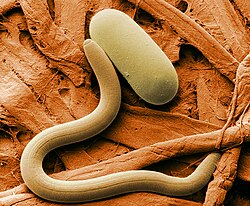
Back وحيش مجهري Arabic Microfauna Catalan Mikrofauna German Mikrofauna Estonian ریززیاگان Persian Microfaune French Mikrofauna ID Микрофауна Kazakh Microfauna Portuguese Микрофауна Russian

Microfauna (Ancient Greek mikros "small" + Neo-Latin fauna "animal") refers to microscopic animals and organisms that exhibit animal-like qualities, and have body sizes that are usually <0.1mm.[1][2] Microfauna are represented in the animal kingdom (e.g. nematodes, small arthropods) and the protist kingdom (i.e. protozoans). A large amount of microfauna are soil microfauna which includes protists, rotifers, and nematodes. These types of animal-like protists are heterotrophic, largely feeding on bacteria. However, some microfauna can consume other things, making them detritivores, fungivores, or even predators.[3]
- ^ Dettwyler, Katherine A. (2011). Cultural anthropology & human experience : the feast of life. Long Grove, IL. ISBN 9781577666813. OCLC 706024344.
- ^ Fernández-Luqueño, Fabián; Vázquez-Núñez, Edgar; Pérez-Hernandez, Hermes (2023-01-01), La Rosa, Guadalupe De; Peralta-Videa, Jose R. (eds.), "Chapter 4 - Biophysicochemical transformations of ENMs in soil", Physicochemical Interactions of Engineered Nanoparticles and Plants, Nanomaterial-Plant Interactions, vol. 4, Academic Press, pp. 89–114, ISBN 978-0-323-90558-9, retrieved 2024-02-13
- ^ Haynes, Richard John (2014-01-01), Sparks, Donald (ed.), "Chapter Two - Nature of the Belowground Ecosystem and Its Development during Pedogenesis", Advances in Agronomy, vol. 127, Academic Press, pp. 43–109, doi:10.1016/b978-0-12-800131-8.00002-9, retrieved 2024-02-29
© MMXXIII Rich X Search. We shall prevail. All rights reserved. Rich X Search